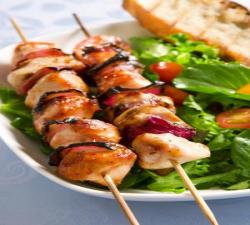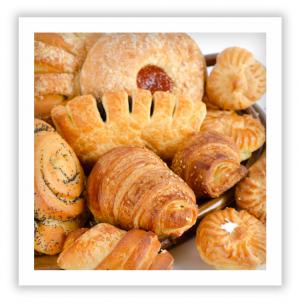Cooking with Olive Oil
Enjoy the Dishes You Love Even More
Cooking in the restaurant or at home
Olive Oil is an essential ingredient for those who love flavorful, healthy food. For those who already know the wonderful attributes of a good olive oil, we invite you to enjoy our succulent recipes. Not only will you enjoy the food preparation process, but you will pleasantly impress your guests.
For those who are new to cooking with olive oil, these insights into the value and usefulness of olive oil will help you in food preparation.
There are no hard and fast rules for cooking with Olive Oil. You can be as innovate as you want. However, here a few quick tips that will guide your creativity and help you achieve the flavor, texture, and appearance you desire.
-
Use high quality gourmet Olive Oil.
-
Think of Olive Oil as a food, not just an ingredient or seasoning.
-
Use the appropriate grade of Olive Oil for different types of food preparation. As with wine, select the approrpitate grade to complement other flavors and ingredients in the dishes you are creating.
Here are some tips for using Castillo de Piñar in your everyday cooking.
 Dressing, Drizzling, Dipping and Marinating Dressing, Drizzling, Dipping and Marinating
Organic or Extra Virgin Olive Oil
Olive Oil is integral as part of a dressing served over a salad filled with nutritious fruits and vegetables. To get the most out of the exquisite taste and aroma, use our Organic Extra virgin olive oil or our Extra Virgin Olive OIl. By adding flavor to uncooked dishes, such as salads, soups or sauces, you will add intensity and depth of flavor to your food.
Olive Oil is also ideal for making vinaigrettes. Olive oil balances the acidity in high-acid foods, such as tomatoes, lemon juice, vinegar and wine.
When mixed together with herbs and spices the olive oil enables the mixture to blend perfectly together. Castillo de Piñar has its own unique taste, aromas and nuances which comes from the well-tended Picual olive. It is great for marinades or sauces for meat, fish, poultry, and vegetables, helping the marinade penetrate into the first few layers of the food being marinated.
Chef’s Suggestions
-
When dressing a salad add your seasoning first and then your vinegar. Make sure olive oil is the last thing you add to the salad, this will allow the seasoning to blend with your vegetables and fruit.
-
Olive oil intensifies the flavor of food, so you can use it to increase the spiciness.
-
Use Olive oil on crusted bread, alone or blended with herbs and spices. Look for recipes on our cooking section.
-
Pouring olive oil over foods already cooked will intensify the taste, as well as improve your presentation by adding enhancing the natural colors of the food.
-
Before refrigerating homemade pesto, add a thin layer of fine virgin olive oil on top of the sauce after putting it in a jar so the pesto will keep its green color.
 Grilling Grilling
Extra Virgin Olive Oil or Virgin Olive.
Olive oil can preserve the natural juices of broiled, roasted or grilled meats. Brush extra virgin or virgin olive oil over your favorite vegetables, meat, poultry or seafood before grilling to seal in the flavor, moisture, and natural juices, while crisping the exterior.
Chef’s Suggestions
-
If you brush your chicken or fish with Olive oil before baking it, it will make that chicken skin crisp and delicious, just how you like it!
-
Brush olive oil over corn on the cob before slowly grill it at a low temperature. Dashing salt and pepper over it before serving it up hot and tasty.
Frying & Sautéing
Virgin Olive Oil
Unlike other oils, Castillo de Piñar Olive Oil is able to withstand high temperatures without breaking down and forming a toxic compound. Olive oil smoke points vary depending on the quality of the olive oil.
According to the IOC (International Olive Council which is in Madrid, Spain), Olive oil is ideal for frying. In proper temperature conditions, without over-heating, it undergoes no substantial structural change and keeps its nutritional value better than other oils, not only because of the antioxidants in it but also due to its high levels of oleic acid.
The smoke point of Olive Oil (210ºC)is substantially higher than the ideal temperature for frying food (180ºC). Other fats such as corn oil or butter have lower smoke points, so they break down at this temperature and form toxic products. Olive Pomace Oil, which is used mainly by restaurants, has a smoking point of 460°F/238°C, which also tends to vary depending on its blend and quality.
Make sure you are manage the grill temperatures carefully. When fried at the proper temperature, olive oil forms a protective crust that helps maintain moisture inside the food which prevents your food from sticking or becoming greasy. Frying with olive oil is much healthier, and tasty, too.
Chef’s Suggestions:
-
When frying, high heat is essential, as frying with lower temperatures will draw out the juices, which results in steaming instead of browning. However, make sure the oil is not smoking. If it is, dispose of it - it has a low smoke point and is unsuitable for frying at high temperatures.
-
Make sure that any food that you are going to fry, such as vegetables, poultry or meat is rinsed and dried before putting it in the hot pan.
-
When frying battered, floured or breadcrumb-coated foods, fry between 310-340ºF (155ºC-170ºC).
-
For deep-frying, raise temperature to 350-375ºF (180-190ºC).
-
Do not be afraid to use plenty of Olive Oil.
-
Make sure to batter food before frying so it does not become soggy. If you overcrowd the pan it will cause for the temperature of the oil to drop making the food soggy. Make sure you have enough oil in the pan so it covers completely the food.
-
You want to get a nice brown before flipping or turning the food.
 Baking Baking
Virgin Olive Oil
Most people don't think of using olive oil when baking, but it's actually a great way to get more monounsaturated fat and polyphenolic compounds into your diet. We recommend our Castillo de Piñar Virgin Olive Oil for baking. It has the perfect blend of its Picual and Arbequina olives to give it a mild flavor ideal for baking. It is especially good for baking savory breads, cakes, cookies, and other pastries. Because of its high smoke point our Virgin olive oil withstands high-heat cooking methods. Next time you are baking, try using virgin olive oil as a healthy alternative to butter.
Olive Oil is Reuseable
Unlike many other oils, olive oil is reusable. Straining the oil to remove particulate matter that may be left over from cooking can help clean the oil, extending its life and re-useability. Here are some tips for reusing your oil:
-
When frying potatoes, vegetables or eggs that do not leave any residue behind, you can use it up to 6 times. Some people take good care of their oil and use it even more but if you are conservative like I am 6 is a good number. If for any reason you have burned the oil, or your oil has gotten dark you may not want to continue using it.
-
Meats usually dirty oil faster so I recommend about 3 to 4 times.
-
Olive Oil retains some of the flavor of the food that was cooked in it. For this reason, you may want to save olive oil that has been used to cook fish in a different container. If you fry potatoes or other foods in that oil, they will have a fish flavor. However, there are times when this property of olive oil can be a good thing. for example, you can use the oil that has been used to fry garlic to fry your chicken, giving them a wonderful garlic flavor.
Using Olive Oil in place of Butter or Margarine
 Did you know you can use Olive Oil in place of butter or margarine? It is absolutely true! Substituting olive oil for butter or margarine dramatically reduces the fat content in your baked goods, especially saturated fat. Did you know you can use Olive Oil in place of butter or margarine? It is absolutely true! Substituting olive oil for butter or margarine dramatically reduces the fat content in your baked goods, especially saturated fat.
Olive Oil is rich in Monounsaturated fats. This is the healthy fat that your body needs to function correctly. Olive Oil naturally reduces LDL (Low Density Lipoproteins - bad cholesterol) and increases HDL (High Density Lipoproteins - good cholesterol), cleaning out excess cholesterol. According to the Cleveland Clinic, butter is high in LDL (bad cholesterol) and saturated fats which raise the level of bad cholesterol. Margarine is rich in trans-fat which is shown to increase your bad cholesterol.
Butter - Olive Oil Conversion Chart
Olive Oil will help your dishes be richer in flavor and at the same time healthier. Use this standard conversion chart when baking; your product will turn out as you expected but with 25% less cholesterol.
|
Butter/Margerine |
|
Olive Oil |
|
1 teaspoon |
|
3/4 teaspoon |
|
1 Tablespoon |
|
2 1/4 teaspoons |
|
2 Tablespoons |
|
1 1/2 Tablespoon |
|
1/4 cup |
|
3 Tablespoons |
|
1/3 cup |
|
1/4 cup |
|
1/2 cup |
|
1/4 cup + 2 Tablespoons |
|
2/3 cup |
|
1/2 cup |
|
3/4 cup |
|
1/2 cup + 1 Tablespoons |
|
1 cup |
|
3/4 cup |
|